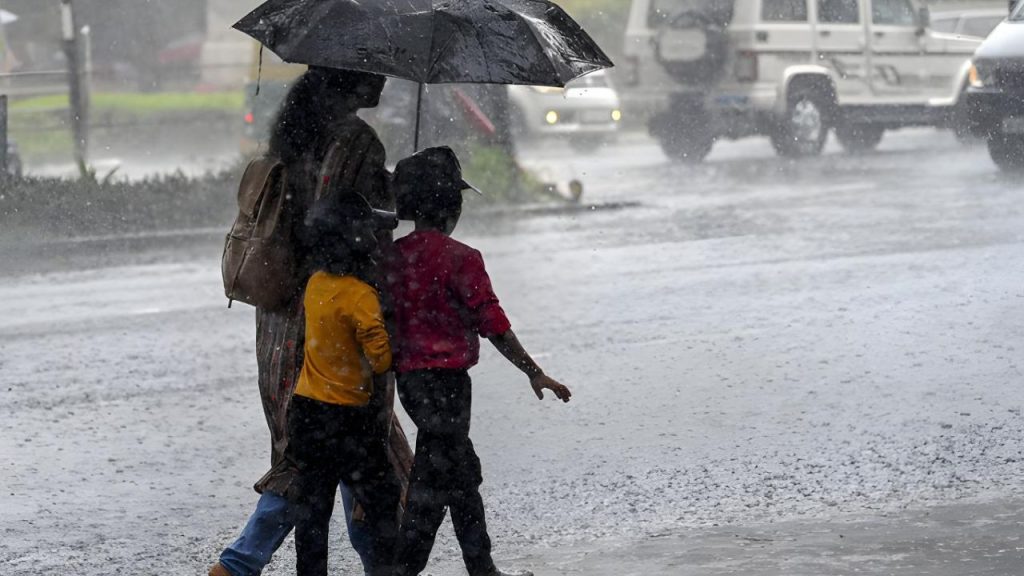
The India Meteorological Department (IMD) has issued an orange alert for Hyderabad, warning of heavy rainfall over the upcoming weekend. The alert signifies the potential for significant weather disruptions, urging residents to prepare for adverse conditions including intense rain, strong winds, and possible flooding. The IMD’s forecast predicts a generally cloudy sky with moderate to heavy rain or thundershowers, accompanied by gusty winds reaching speeds of 30-40 kmph. As Hyderabad gears up to face these challenging weather conditions, understanding the implications of the alert and preparing accordingly will be crucial.
Understanding the IMD’s Orange Alert
An orange alert is the second highest level of warning issued by the IMD, indicating that people need to be prepared for severe weather conditions that could lead to disruption of normal life. The alert serves as a call to action for residents, local authorities, and emergency services to take preventive measures to mitigate the impact of the expected weather. In the case of Hyderabad, the orange alert suggests that heavy to very heavy rainfall is likely over the weekend, posing risks such as water pooling on roads, traffic congestion, and potential damage to infrastructure.
The IMD’s warning covers both Saturday and Sunday, highlighting the potential for prolonged and intense rainfall. The forecast includes moderate to heavy rain or thundershowers, with the possibility of thunderstorms accompanied by gusty winds. Such conditions can lead to several challenges, including the risk of flooding in low-lying areas, disruptions to transportation, and interruptions to essential services such as electricity and water supply.
Impacts of Heavy Rainfall on Hyderabad
Hyderabad, like many urban areas, is susceptible to flooding and waterlogging during heavy rains, primarily due to rapid urbanization, inadequate drainage systems, and the city’s geographical layout. The potential impacts of the forecasted heavy rainfall include:
Flooding and Waterlogging: Hyderabad’s infrastructure, particularly in low-lying and densely populated areas, often struggles to cope with heavy downpours. Water pooling on roads and streets can create dangerous conditions for pedestrians and vehicles alike, leading to increased traffic congestion and the potential for accidents. Low-lying neighborhoods and areas near lakes or water bodies are at particular risk of flooding, which can damage homes and disrupt daily life.
Traffic Disruptions: The city’s road network is likely to face significant strain during the heavy rainfall, with wet and slippery roads posing hazards for drivers. Traffic congestion is expected at most locations, exacerbated by reduced visibility, fallen trees, and possible accidents. Public transportation, including buses and auto-rickshaws, may experience delays, further impacting the daily commute for many residents.
Power and Water Supply Interruptions: Severe weather conditions often lead to disruptions in essential services. The IMD has warned of the potential for disturbances to electricity, water, and other critical services for several hours. Strong winds and rain can cause trees and electric poles to fall, leading to power outages in affected areas. Additionally, clogged drains and waterlogged streets can impede the supply of clean water, adding to the challenges faced by residents.
Infrastructure Damage: The combination of heavy rain and gusty winds can pose a threat to infrastructure, including roads, buildings, and public utilities. The risk of trees and electric poles falling is heightened during such weather, which can cause damage to vehicles, property, and public amenities. Prolonged exposure to heavy rain can also weaken the foundations of structures, leading to safety concerns.
Health and Safety Risks: Heavy rainfall and flooding bring health risks, such as waterborne diseases due to contaminated water sources, and accidents caused by slipping or falling in waterlogged areas. There is also an increased risk of electrocution in areas where electrical infrastructure is compromised. Ensuring safety during such weather requires vigilance and adherence to safety protocols.
Preparedness and Safety Measures
Given the IMD’s orange alert, it is imperative for residents of Hyderabad to take necessary precautions to ensure their safety and minimize the impact of the heavy rainfall. Here are some key measures to consider:
Stay Informed: Keep updated with the latest weather forecasts and alerts from reliable sources such as the IMD, local news, and official government channels. Staying informed will help you make timely decisions and take appropriate action in response to changing weather conditions.
Avoid Non-Essential Travel: With the potential for traffic congestion and hazardous road conditions, it is advisable to avoid non-essential travel during the forecasted heavy rainfall. If travel is necessary, plan your route carefully, allow extra time for delays, and drive cautiously. Use public transportation where possible, as it may be better equipped to navigate flooded roads.
Secure Your Home: To protect your home from potential flooding, ensure that drains and gutters are clear of debris, which can block the flow of water and exacerbate flooding. Consider using sandbags or other barriers to prevent water from entering your home, especially in areas prone to waterlogging. Secure outdoor furniture and other items that could be blown away by strong winds.
Prepare for Power Outages: Given the possibility of electricity disruptions, have a backup plan for lighting and communication. Keep flashlights, batteries, and power banks charged and ready for use. If you rely on electrical equipment for health reasons, ensure that you have a backup power source or alternative arrangements in place.
Stock Up on Essentials: Heavy rain and flooding can disrupt the supply of essential goods, so it is wise to stock up on non-perishable food items, drinking water, and other necessities in advance. Ensure that you have sufficient supplies to last through the period of intense weather, especially if you live in a flood-prone area.
Health Precautions: With the increased risk of waterborne diseases, take precautions to ensure access to clean drinking water. Boil water or use water purifiers to reduce the risk of contamination. Avoid wading through floodwaters, as they may be contaminated and pose health risks. Keep a first-aid kit readily available for any minor injuries that may occur.
Emergency Contacts: Have a list of emergency contacts, including local authorities, utility companies, and nearby hospitals, readily available. In case of severe flooding or other emergencies, knowing whom to contact can make a significant difference in the response time and effectiveness of assistance.
Role of Local Authorities and Emergency Services
The IMD’s orange alert places a significant responsibility on local authorities and emergency services to ensure that the city is prepared for the heavy rainfall. Key actions include:
Drainage and Flood Management: Authorities need to ensure that stormwater drains and sewer systems are functioning effectively to minimize waterlogging. Regular clearing of debris from drainage systems and proactive measures to prevent blockages can significantly reduce the risk of flooding.
Public Communication: Effective communication is crucial in alerting residents to the potential dangers of the forecasted weather. Local authorities should provide timely updates on the weather, road conditions, and any disruptions to public services. Use of social media, public announcements, and emergency alert systems can help disseminate critical information quickly.
Emergency Response Preparedness: Emergency services, including police, fire, and medical teams, should be on high alert and prepared to respond to incidents arising from the heavy rainfall. This includes readiness for search and rescue operations, clearing fallen trees, and providing medical assistance where needed.
Shelter and Relief: In the event of severe flooding, temporary shelters should be set up to accommodate displaced residents. Authorities should also have plans in place to distribute relief supplies, including food, water, and medical aid, to those affected by the weather.
Monitoring and Coordination: Continuous monitoring of weather conditions and coordination between various government departments are essential for an effective response. Authorities should work closely with the IMD to stay updated on weather developments and adjust their strategies accordingly.
Community Efforts and Support
Community involvement is also crucial in managing the impact of heavy rainfall. Residents can support each other by:
Helping Vulnerable Neighbors: Check on elderly or vulnerable neighbors who may need assistance with preparations or during the adverse weather conditions. Community support can make a significant difference, especially for those who may not have the means to secure their homes or access essential supplies.
Volunteering: Local organizations and community groups can organize volunteer efforts to assist with sandbagging, clearing drains, or distributing supplies. Volunteering can help alleviate the burden on emergency services and provide crucial support to those in need.
Staying Safe and Responsible: Follow safety guidelines and avoid taking unnecessary risks, such as driving through flooded roads or wading through waterlogged areas. By prioritizing safety, residents can reduce the likelihood of accidents and ensure that emergency services can focus on the most critical incidents.
Long-Term Solutions and Resilience Building
While immediate preparations are crucial, building long-term resilience to heavy rainfall and flooding is equally important for Hyderabad. This involves investing in infrastructure improvements, such as upgrading drainage systems, implementing sustainable urban planning, and enhancing flood management strategies. Additionally, raising public awareness about the risks associated with extreme weather and promoting community resilience can help mitigate the impact of future events.
The orange alert for heavy rainfall serves as a reminder of the challenges posed by extreme weather, particularly in urban environments. By taking proactive measures, staying informed, and supporting one another, the residents of Hyderabad can navigate the weekend’s weather safely and minimize disruptions to their lives.
As Hyderabad braces for the forecasted heavy rain, the combined efforts of individuals, communities, and authorities will be key to weathering the storm. While the orange alert signals the potential for significant impacts, it also underscores the importance of preparedness, resilience, and collaboration in the face of nature’s challenges.
